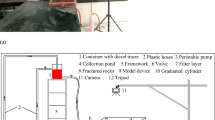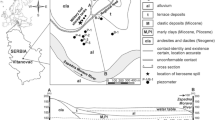Abstract
A natural gradient tracer test with sodium chloride as the injectate was conducted using one injection well and eleven observation wells in an oil-contaminated site in the study area. The aim was to characterize the site and to determine migration rates of the contaminants to provide information on their fate in groundwater resources in the area. The migration of the tracer was constantly monitored by sampling all the observation wells spaced 5 m from each other at 15–30 min intervals for a period of 6 days. The test soil layer is a clayey silty sand consisting of 50 % sand, 30 % silt and 20 % clay. The average static water level at the site is about 2.5 m. Gas chromatography fingerprinting showed that kerosene and diesel are the dominant fractions within the soil matrix. The arrival times of the breakthrough moments of the migrating tracer plume from two observation piezometers situated 2.0 and 7.22 m away from the injection well showed that the mean velocity in the longitudinal direction in the aquifer is 1.403 × 10−3 ms−1 (121 m/day). The longitudinal and transverse dispersion coefficients of 2.45 × 10−3 m2s−1 and 2.3 × 10−3 m2s−1 were used to obtain longitudinal and transverse dispersivities of 1.78 and 1.64 m, respectively. High hydraulic conductivity denoted by the high migration rate of the tracer implies that contaminant at the site will migrate through the aquifer with relative ease. However, the significant clay fraction within the soil provides the medium for adsorption and partitioning of contaminants to the soil.







Similar content being viewed by others
References
Adams MC, Benoit WR, Doughty C, Bodvarsson GS, More JN (1989) Dixie Valley, Nevada tracer test. Trans Geotherm Resourc Counc 13:215–226
Amajor LC (1991) Aquifers in the Benin Formation (Miocene—Recent), eastern Niger Delta, Nigeria: lithostratigraphy, hydraulics, and water quality. J Environ Geol V17(2):85–101
Amajor LC, Ofoegbu CO (1988) Determination of polluted aquifers from Eastern Niger delta, Nigeria. In: Ofoegbu CO (ed) Groundwater and mineral resources of Nigeria. Vieweg & Sohn, Braunschweig, pp 61–74
Batty T (2008) Understanding pollutant movement in groundwater: revisiting the K d concept. In: U21 Post Graduate Conference Proceedings 1, 20th–25th July, 2008, University of Birmingham, pp 20–23
Bear J, Cheng AHD (2009) Modeling groundwater flow and contaminant transport. Springer, London, pp 351–356
Chiang WH (2005) 3D groundwater modeling with PMWIN. A simulation system for modeling groundwater flow and transport processes. Springer, New York, pp 340–385
Department of Petroleum Resources, DPR (1992) Environmental guidelines and standards for the petroleum industry in Nigeria. EGASPIN, Lagos
Domenico PA, Robbins GA (1984) A dispersion scaled effect in model calibrations and field tracer experiment. J Hydrol 7:121–132
Domenico PA, Schwartz FW (1990) Physical and chemical hydrogeology. Wiley, New York, pp 360–385
Etu-Efeotor JO, Akpokodje EG (1990) Aquifer systems of the Niger Delta. J Min Geol 26(2):279–284
Fetter CW (1990) Contaminant hydrogeology, 2nd edn. Prentice Hall, USA, pp 671–694
Field MS (1999) The Q tracer program for tracer breakthrough curve analysis for karst and fractured rock aquifers. J Environ Syst 23(4):1–43
Gelhar LW, Gutjahr AL, Naff RL (1979) Stochastic analysis of macro dispersion in a stratified aquifer. Water Resour Res. 15(6):1387–1397
Jackson RE (1980) Aquifer contamination and protection. In: Ground-Water Contamination Inventory, IHP-VI Series on Groundwater, No. 2, pp 44–57
Kao CS, Hunt JR (2001) Experimental validation and applications of a fluid infiltration model. J Environ Eng 127(2):162–169
Kilpatrick FA, Wilson Jr JF (1989) Measurement of time of travel in streams by dye tracing. Techniques of Water-Resources Investigations of the United States Geological Survey, Book 3. Chapter A9
Kinzelbach W (1986) Groundwater modeling—an introduction with simple programs in BASIC. Elsevier, Amsterdam
Newton PM, Brian LH (1995) A comparison of methods to determine K in a shallow coastal aquifer. Groundwater 33(1):49–57
Palmer CD, Nadon RL (1986) A radial injection tracer experiment in a confined aquifer, Scarborough, Ontario, Canada. Groundwater 24(3):323–331
Robbins GA (1983) Determining dispersion parameters to predict groundwater contamination. Retrieved from: http://www.water.uconn.edu/hydro-Publications.html
Short KC, Stauble AJ (1967) Outline of the geology of the Niger Delta. Bull Am Assoc Petrol Geol 54:761–779
Sudicky EA, Cherry JA, Frin EO (1983) Migration of contaminants in groundwater at a landfill; a case study. J Hydrol 6:81–108
United Nations Development Programme, UNDP (2006) Niger Delta Human Development Report. P76, http://www.hdr.undp.org/en/reports/nationalreports/africa/nigeria. Retrieved on 19 June 2011
United Nations Environment Programme, UNEP (2011) Environmental assessment of Ogoniland, pp 1–198. Retrieved from: http://www.unep.org
Weight WD, Sonderegger JL (2000) Manual of applied field hydrogeology. McGraw-Hill, New York, pp 473–568
World Health Organisation, WHO (2004) Guidelines for drinking water quality, vol 1, 3rd edn. “Recommendations”. Geneva
Author information
Authors and Affiliations
Corresponding author
Rights and permissions
About this article
Cite this article
Giadom, F.D., Akpokodje, E.G. & Tse, A.C. Determination of migration rates of contaminants in a hydrocarbon-polluted site using non-reactive tracer test in the Niger Delta, Nigeria. Environ Earth Sci 74, 879–888 (2015). https://doi.org/10.1007/s12665-015-4094-3
Received:
Accepted:
Published:
Issue Date:
DOI: https://doi.org/10.1007/s12665-015-4094-3




